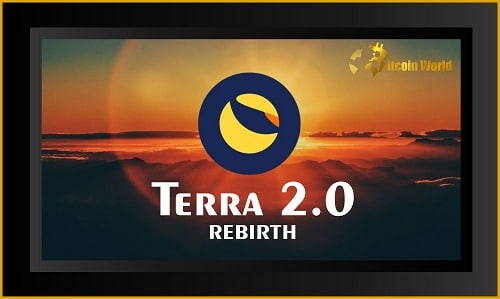Remember the Terra Luna crash? It shook the crypto world, leaving many traders in disbelief. But in the ever-dynamic world of cryptocurrency, even from the deepest falls, there can be a rise. Do Kwon and the Terraform Labs team have officially launched their ambitious recovery plan: Terra 2.0. Yes, you heard that right. A new Terra blockchain is here, aiming to rise from the ashes of the previous collapse. Let’s dive into what this means for you, the crypto trader.
Terra 2.0 is Born: A New Chain Emerges
As announced on May 27th, the Terra ecosystem has voted in favor of Proposal 1623, effectively giving birth to a brand new blockchain. Think of it as a digital phoenix rising. The original Terra blockchain isn’t disappearing entirely; instead, it’s being rebranded as Terra Classic. The new chain will simply be known as Terra, and crucially, it will operate without the algorithmic stablecoin that was central to the previous ecosystem’s downfall.
Goodbye LUNA, Hello LUNA (and LUNC)! Navigating the Token Renaming
Keeping track of the token names? It can get a little confusing, but here’s the breakdown to keep you in the loop:
- Old LUNA Token: This is now officially Luna Classic (LUNC).
- New LUNA Token: The token for the new Terra 2.0 chain will be called LUNA. Yes, the same name, but representing a completely different blockchain and ecosystem.
So, when you hear ‘LUNA’ moving forward, it almost always refers to the token of the new Terra 2.0 chain. Luna Classic (LUNC) represents the legacy chain and its token.
The LUNA 2.0 Airdrop: Who Gets What and When?
A key part of the Terra revival plan is the airdrop of the new LUNA tokens to holders of the old LUNA and UST cryptocurrencies. Do Kwon and his team have set up an airdrop mechanism to distribute the new LUNA tokens. Here’s what you need to know about the airdrop:
- Airdrop Date: The airdrop for eligible holders started on Thursday, May 26th.
- Snapshot Basis: Eligibility is determined based on snapshots taken of the previous Terra network at two crucial points:
- Pre-attack snapshot: For those who held LUNA before the major crash.
- Post-attack snapshot: For those who held UST or LUNA *after* the crash but potentially still during the recovery attempts.
- Verification: Your holdings at the time of these snapshots will determine how many new LUNA tokens you receive.
Important Caveats: Snapshot Exclusions
Terra has highlighted some important limitations regarding the snapshot. Not all LUNA and UST holdings are automatically included. Pay attention to these points:
- Bridged Assets: If you held LUNA or UST on bridges *outside* of the Terra blockchain, you need to bridge them back to the Terra blockchain to be included in the post-attack snapshot. This is crucial if you want to be eligible for the airdrop based on those holdings.
- CW3 Multi-sig Contracts: Holdings of UST and LUNA within CW3 multi-signature contracts are generally excluded from the snapshot.
- Edge Cases: While the aim is to include the majority of UST and LUNA holders, there might be some edge cases that are not covered. It’s always best to check official Terra channels for the most up-to-date information and any specific situations.
Crypto Exchanges Jump on Board: Support for Terra 2.0
A positive sign for the new Terra chain is the support from major crypto exchanges. Binance, one of the world’s leading exchanges, has already announced its support for the Terra 2.0 launch and the LUNA airdrop. This kind of exchange support is vital for the liquidity and accessibility of the new token. Other exchanges are likely to follow suit, which will be crucial for the success of Terra 2.0.
What Does This Mean for Crypto Traders? Key Takeaways
The launch of Terra 2.0 is a significant event in the crypto space. Here’s what crypto traders should consider:
- A High-Risk, High-Reward Scenario: Terra 2.0 is essentially a fresh start. It’s a highly speculative venture. While there’s potential for growth and recovery, there’s also significant risk involved. Approach with caution and only invest what you can afford to lose.
- Monitor Exchange Listings: Keep an eye on your preferred crypto exchanges to see when and how they list the new LUNA token. This will affect trading volume and price discovery.
- Understand the Airdrop Mechanics: If you held LUNA or UST previously, understand the airdrop rules and eligibility criteria. Check official Terra resources to ensure you receive your allocated tokens.
- Focus on Fundamentals (This Time): Terra 2.0 is attempting to build a new ecosystem without the algorithmic stablecoin model that led to the previous collapse. Pay close attention to the projects and applications built on this new chain. Long-term success will depend on genuine utility and adoption.
- Be Aware of Volatility: Expect significant price volatility in the initial days and weeks of LUNA 2.0 trading. News, market sentiment, and overall crypto market conditions will all play a role.
Looking Ahead: Can Terra 2.0 Rise Again?
The crypto community is watching closely to see if Terra 2.0 can truly rebuild and regain trust. The path ahead is uncertain, and the shadow of the previous crash looms large. However, the launch of a new chain and the support from exchanges offer a glimmer of hope for those invested in the Terra ecosystem. Whether Terra 2.0 becomes a successful phoenix story or another chapter in crypto’s volatile history remains to be seen. For now, crypto traders should proceed with informed caution and stay updated on the latest developments in this evolving situation.
Related Posts – The Indian Finance Minister hails blockchain technology
Disclaimer: The information provided is not trading advice, Bitcoinworld.co.in holds no liability for any investments made based on the information provided on this page. We strongly recommend independent research and/or consultation with a qualified professional before making any investment decisions.


